
Monday, November 13, 2017
CSE Alumna Accepts Major Award in Electronic Design Automation
CSE alumna Ayse Coskun (Ph.D. '09) is back in Southern California on Monday, November 13 accepting an award from the Council on Electronic Design Automation (CEDA). The 2017 IEEE CEDA Ernest S. Kuh Early Career Award will be given to Coskun during the opening session in Irvine of the 36th International Conference on Computer Aided Design (ICCAD), the premier conference devoted to technical innovations in electronic design automation (EDA).
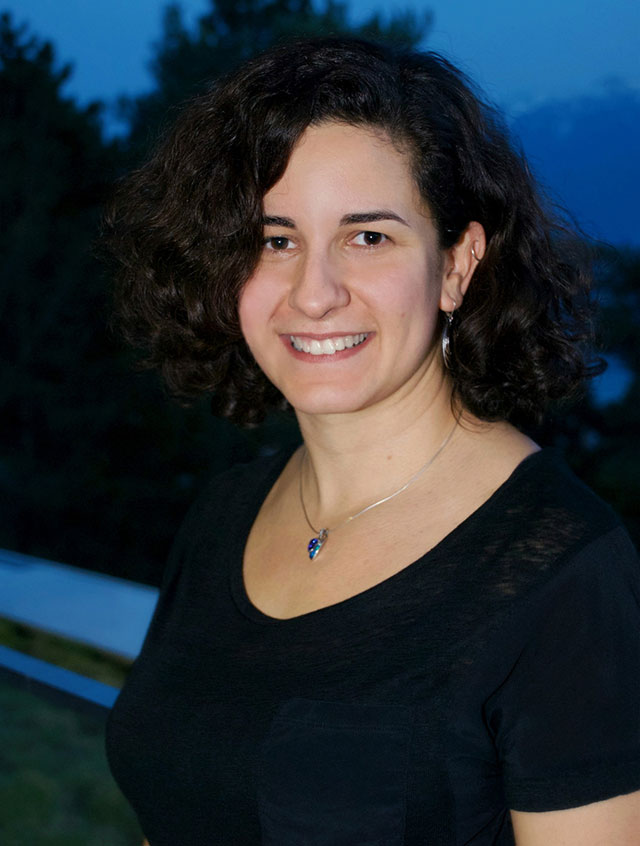
is now an associate professor at
Boston University.
The Awards Committee cited Coskun's "sustained and outstanding contributions to energy-efficient system-level design, including temperature-aware design and management, 3D-stacked system design, and management of large-scale computing systems."
"I am delighted to accept the Early Career Award," said Coskun, who is now a professor in the Electrical and Computer Engineering Department at Boston University (BU). "I am particularly honored because the award is available to a large number of outstanding nominees from both industry and academia, so the competition must have been intense."
Coskun credits some of her success to her years at UC San Diego, where she worked in the System Energy Efficiency Lab (SEE Lab) led by her Ph.D. advisor, CSE Professor Tajana Simunic Rosing. "There is a direct line from my work with Prof. Rosing to my current research interests," said Coskun. "I started my projects on proactive thermal management and 3D-stacked architectures while I was a Ph.D. student at UC San Diego." Other current interests of Coskun include modeling and optimizing systems with new technologies (e.g., systems with optical networks or co-design with cutting edge nanoscale cooling devices) and large-scale system analytics for cloud and HPC systems.
The Early Career Award honors an individual who has made innovative and substantial technical contributions to the area of Electronic Design Automation in the early stages of his or her career. To qualify for consideration, candidates must be nominated no more than eight years after receiving their Ph.D. (or other terminal degree).
2017 has been a year of honors for the CSE alumna. Earlier this year, Coskun and her group accepted the Gauss Award. The collaborative BU and Sandia Labs team led by Coskun took home the award (and 3,000 euros) for their research paper on "Diagnosing Performance Variations in HPC Applications Using Machine Learning" at the 2017 ISC High Performance Conference (ISC 2017) last June in Frankfurt, Germany. This year Coskun also received a Dean's Catalyst Award from BU - an award she also received in 2010 in her first year on the BU faculty.
Sherief Reda is a Coskun
collaborator and fellow
UC San Diego and CSE
alumnus (Ph.D. '06).
In the spring, Sandia National Laboratories awarded a $490,000 grant to Coskun and fellow BU professor Manuel Egele, They will use the funding to design automated analytics for improving efficiency and security of high-performance computing systems. Specifically, they aim to identify which data collected out of HPC systems would be useful for identifying performance characteristics, inefficiencies, and malicious behavior. Subsequently, Coskun and Egele will design automated methods to leverage these data to take runtime actions to improve efficiency and security.
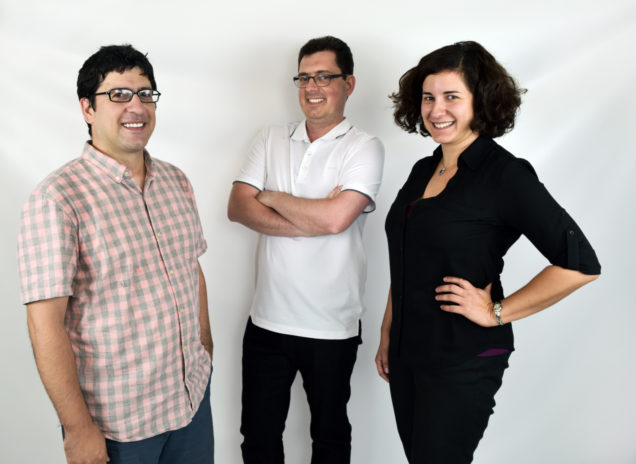
(l-r): research scientist Ata Turk and professor Manuel Egele
(Photo courtesy BU College of Engineering)
Professor Coskun's past recognitions include an NSF CAREER Award in 2012, and in 2011, a Best Paper Award from the High Performance Embedded Computing (HPEC) Conference. Also in 2011, she was named a Junior Faculty Fellow at the Rafik B. Hariri Institute for Computing at BU. Coskun is currently an associate editor of the IEEE Transactions on Computer Aided Design.
The CSE alumna is also looking to the future, notably March 2018 and the Design, Automation and Test in Europe conference (DATE 2018) in Dresden, Germany. Coskun is the Program Chair of this large pioneer conference in electronic design automation.
Coskun's Ph.D. advisor, CSE Professor Rosing, will also be attending ICCAD in Irvine, CA. She is scheduled to speak at the 10th IEEE/ACM Workshop on Variability, Modeling and Characterization (VMC 2017), co-located with ICCAD.
Ayse Coskun Homepage
ICCAD 2017
Gauss Award Paper at ISC 2017
Profile of Ayse Coskun by BU College of Engineering
Fruit Fly Brain Informs Search Engines of the Future
Every day, websites you visit and smartphone apps that you use are crunching huge sets of data to find things that resemble each other: products that are similar to your past purchases; songs that are similar to tunes you've liked; faces that are similar to people you've identified in photos. All these tasks are known as similarity searches, and the ability to perform these massive matching games well-and fast-has been an ongoing challenge for computer scientists.
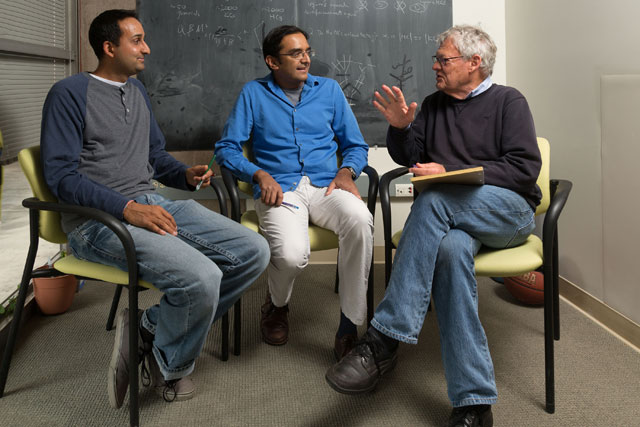
Charles Stevens. (Photo courtesy Salk Institute)
Now, Salk and UC San Diego scientists have discovered that the fruit fly brain has an elegant and efficient method of performing similarity searches. For flies, it helps them identify odors that are most similar to those they've encountered before, so they know how to behave in response to the odor, such as to approach or avoid it. New details on the fly's computational approach to smelly similarity searches, described in the journal Science on November 9, 2017, could inform computer algorithms of the future.
"This is a problem that pretty much every technology company with any kind of information retrieval system has to solve, so it's been something that computer scientists have studied for years," says Saket Navlakha, assistant professor in Salk's Integrative Biology Laboratory and lead author of the new paper. "Now, we have this new approach to similarity searches thanks to the fly."
Borrowing a page from biological science, Navlakha and his co-authors, fellow Salk Institute professor Charles F. Stevens from its Molecular Neurobiology Lab, and UC San Diego computer science and engineering professor Sanjoy Dasgupta, recognized that something akin to similarity search occurs in nature.
Navlakha's collaborators say that the study is among the first to make such concrete parallels between neural circuits in the brain and information processing algorithms used in computer science.
"For the past 20 years I've been interested in random projections [a core component of locality-sensitive hashing for similarity search] as they apply to algorithms running on computers," said UC San Diego's Dasgupta, first author of the new paper. "It never occurred to me that similar operations may be at work in nature."
The way most computerized data systems categorize items, from songs to images, to optimize similarity searches is by reducing the amount of information associated with each item. These systems assign short "hashes" to each item so that similar items are more likely to be assigned the same or a similar hash compared to two very different items. (Hashes are a kind of digital shorthand, the way a bitly URL is a shorter version of a URL.) Assigning hashes in this way is called "locality-sensitive hashing" to computer scientists. When searching for similar items, a program looks through the hashes, rather than the original items, to find similarities quickly.
"A dream shared by neurobiologists and computer scientists is to understand how the brain computes well enough that we can adapt its methods to improve machine computation," adds Stevens. "Our paper provides a proof of principle that this dream may become reality."

search algorithm based on odor. (Photo
courtesy Salk Institute)
Navlakha and his collaborators' review of the literature revealed that when fruit flies first sense an odor, 50 neurons fire in a combination that's unique to that smell. But rather than hashing that information by reducing the number of hashes associated with the odor, as computer programs would, flies do the opposite-they expand the dimension. The 50 initial neurons lead to 2,000 neurons, spreading out the input so that each smell has an even more distinct fingerprint among those 2,000 neurons. The brain then stores only the 5 percent of those 2,000 neurons with the top activity as the "hash" for that odor. The whole paradigm helps the brain notice similarities better than it would compared to reducing the dimension, Navlakha says.
"Say you have a bunch of people clustered by their relationships, and they're bunched into a crowded room," he explains. "Then take the same people and relationships, but have them spread out on a football field. It will be much easier to see the structure of relationships and draw boundaries between groups in the expanded space relative to the crowded space."
Read the full original news release on the Salk Institute News page.
Watch a Salk Institute animation depicting how fruit-fly brain neurons inform search engines of the future.
Computer Scientist and Oceanographer Realize Long-Time Dream for Undersea Exploration
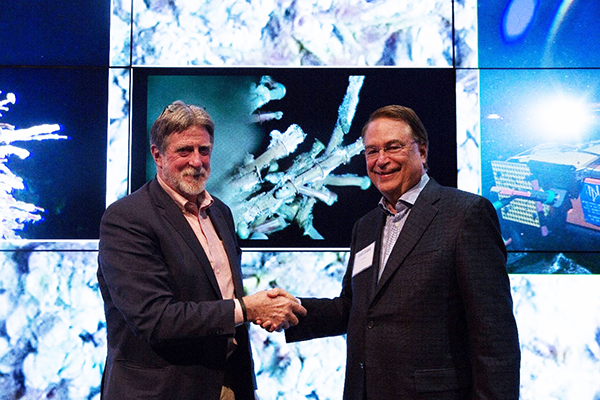
delivery of remote-controlled HD video live feed to large
display in Qualcomm Institute tiled display system.
CSE professor Larry Smarr began talking with University of Washington oceanographer John Delaney in 2004 about the possibility of deploying networked observatories deep on the ocean floor to observe interesting undersea ecosystems. Eventually they teamed on proposals funded by the National Science Foundation (NSF), including for the Ocean Observatories Initiative (OOI). Some 13 years after they first met, Smarr and Delaney were on hand to watch the first-ever live, public video transmission in high definition from a robotic camera and observatory roughly 1.5 kilometers (km) below the ocean's surface and approximately 400 kms offshore and due west of Astoria, Oregon.
Delaney and Smarr - who also directs the California Institute for Telecommunications and Information Technology (Calit2) - watched the live feed in late October along with more than 120 other attendees at the 2017 National Ocean Exploration Forum (NOEF), hosted by Calit2's Qualcomm Institute at UC San Diego. The forum included a handful of high-tech demos, including the video feed from the 15-feet-tall active Mushroom hydrothermal vent 'chimney'. The demos were consistent with the meeting's theme, "Ocean Exploration in a Sea of Data."

Mushroom hydrothermal venting structure
captured at regular intervals by HD Video
Survey
The video feed, managed by UW's Delaney, portrayed in real time the biological and physical dynamics from the OOI Cabled Array observatory located near hydrothermal vents on the caldera of Axial Seamount, a live submarine volcano on the Juan de Fuca Ridge, a mid-ocean spreading center that separates the Pacific Plate to the west and the Juan de Fuca Plate to the east off the coast of Washington and Oregon. The site is so deep that, in the absence of the sunlight necessary for photosynthesis, a diverse community of organisms thrives on thermo-chemical outputs fed by water emerging from the ocean floor at up to 250 degrees Celsius. The real-time HD video feed was displayed on a large, 64-megapixel display wall in the Qualcomm Institute for viewing by NOEF attendees.
The OOI Cabled Array undersea observatory features 22 instruments, including CamHD, an at-sea robotic camera. Remote control of the camera augments the routine direct transmissions of pre-programmed video scans of Axial Seamount.
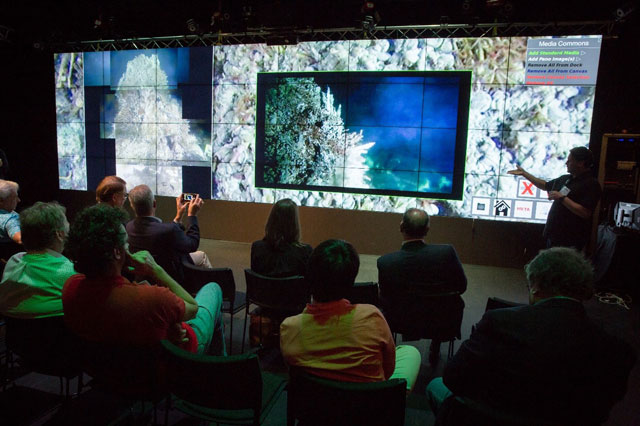
from ocean floor observatory in real time on UCSD 10 feet
by 36 feet display at QI.
For CSE's Smarr and UW's Delaney, the demo at NOEF was a long time coming. They first discussed prototyping remote, real-time interaction with sea-floor systems when they met at an NSF workshop in 2004. Originally conceived on a bar napkin at the 1991 meeting of the American Geophysical Union, Delaney's eventually launched the North East Pacific Time-series Undersea Networked Experiments (NEPTUNE) project. Then Smarr and Delaney collaborated on a 2004 NSF grant for the Laboratory for the Ocean Observatory Knowledge Integration Grid (LOOKING), which led in turn, in 2007, to a grant to build the OOI. Initial operation of the cabled observatory at Axial Seamount began in October 2014.
It was deeply gratifying," said Delaney, "to finally bring to fruition, before a distinguished group of ocean explorers, our long-sought-after vision of routinely interacting, in real time, with a variety of rapidly changing ecosystems operating more than 400 km offshore."
Smarr watched the stunning live video on the Qualcomm Institute's display wall with other attendees at the exploration forum, 13 years after he and Delaney first talked about deploying networked technology on the ocean floor.
"I stood there," recalled Smarr, "not really being able to believe that the dream John and I have had for so long was actually happening."
Read the complete news release about the live video demo from the OOI Cabled Array.
Teaching Students How to Land an Internship Interview or Become a CSE Tutor
CSE undergraduates turned out this week for two important sessions organized by the student-run Computer Science and Engineering Society (CSES) for the 2017-2018 academic year.

on November 2, 2017.
On Monday, Nov. 6, CSES held its first Professor/Tutor Panel of the year. The session invited students to learn more being a tutor, and how tutors help students and liaise with professors and lecturers to reinforce learning goals outside of the classroom. The panel discussion also provided a roadmap on how students - some still in their freshman year - can become a tutor in specific classes. The panel included CSE lecturers Rick Ord and Paul Cao, along with 18 CSE tutors, who were able to convey their own experiences in helping students improve on learning outcomes, especially in programming courses for students who entered their freshman year with little experience with programming from high school. The event took place in the Multipurpose Room of the Student Services Center.
The following day, on Tuesday, Nov. 7, CSES organized the inaugural session of its Intern Series for the current academic year. The first session of the Intern Series focused on Getting the Interview. The session took place from 6:30pm to 9pm in the Price Center East Ballroom. Students in attendance learned how to approach recruiters, what to put on their resumes, and specific advice appropriate to students at each year of their undergraduate education, e.g., a first-year undergrad might wonder how to begin the process, while a third-year student might need a refresher session as they look ahead to the summer between their junior and senior years (when CSE student interns are most in demand at technology companies.
The Computer Science and Engineering Society is the longest-standing and widest-reaching computer science organization. CSES brings together everyone at UC San Diego interested in getting involved in their computer science community, and the local chapter has one of the largest communities by turnout as well as in terms of outreach and other support programs.
CSE Undergraduates Urged to Apply for Student Travel Funding This Quarter
The Jacobs School of Engineering Student Travel Fund provides an opportunity for individual students and student organizations to apply for scholarships to supplement costs of conferences or other similar events.
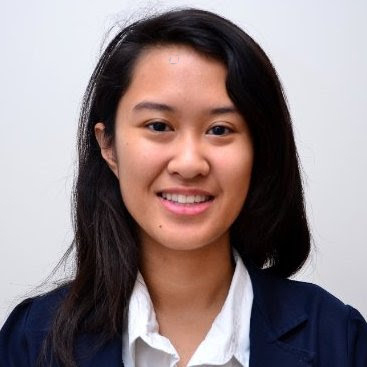
Agcaoili attended a conference
for women in computer in 2016
thanks to a Student Travel Grant.
According to the latest survey of Student Travel Grant respondents, Computer Science and Engineering had the largest cohort of applying individuals and teams - roughly 18.5 percent of total applicants. One CSE student awarded a travel grant from the Fund in 2016 was Kristin Agcaoili, now a senior majoring in Computer Science, who attended the Southern California Celebration of Women in Computing. "It definitely enhanced my experience as a student at UCSD because it taught me about the gap women have in engineering fields and how prominent it was in classes," recalled Agcaoili. "I am now more aware of it... and I am taking steps to encourage women to take part in engineering extra-curriculars. [The Women in Computing conference in 2016] also introduced me to local startups that work with innovative technologies such as Virtual Reality." The second large cohort - with 14.6 percent of survey respondents - came from Bioengineering.
Students applying for these funds are focused on opportunities to increase student visibility and networking, and to improve the participation of women and minority students getting to network at regional, national and international conferences. The selection committee meets every two weeks during the Fall quarter to review applications and determine who is awarded funding.
The Student Travel Fund was made possible by generous donations from the 2013 graduating senior class in conjunction with the annual Ring Ceremony. The seniors came together as Tritons helping to secure enhanced learning opportunities for future Jacobs School students. Awards from this fund help cover costs for undergraduate student travel to conferences and competitions. Now and in future, current seniors from each graduating class help to ensure that awards continue to assist student researchers for years to come.
UPCOMING EVENTS
Enter the Hydra: Towards Principled Bug Bounties and Exploit-Resistant Smart Contracts
As part of the CSE Distinguished Lecture Series, Cornell Tech and Cornell University professor Ari Juels will offer a novel, principled approach to administering and reasoning about bug bounties that cost-effectively boosts incentives for hackers to report bugs.
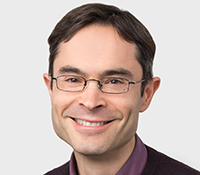
Date: Monday, November 13, 2017
Time: 11am
Location: Room 1202, CSE Building
Abstract: Vulnerability reward programs, a.k.a. bug bounties, are a near-universal component of major software security programs. Today, though, such programs have three major deficiencies. They fail to provide strong technical (or other) assurances of fair payment for reported bugs, lack rigorous principles for setting bounty amounts, and can only effectively incentivize economically rational hackers to disclose bugs by offering rich bounties. As a result, rather than reporting bugs, hackers often choose to sell or weaponize them.
We offer a novel, principled approach to administering and reasoning about bug bounties that cost-effectively boosts incentives for hackers to report bugs. Our key idea is a concept that we call an *exploit gap*. This is a transformation of program code that prevents a serious bug from being exploited as a security-critical vulnerability. We focus on a broadly applicable realization through a variant of the classic idea of N-version programming. We call the result a "hydra program."
As our main target application, we explore *smart contracts*, programs that execute on blockchains. Because smart contracts are often financial instruments, they offer a springboard for our rigorous framework to reason about bounty price setting. By modeling an economically rational hacker's bug-exploitation, we show how hydra contracts greatly amplify the power of bounties to financially incentivize disclosure. We also show how smart contracts can separately enforce *fairness* for bug bounties, guaranteeing payment for correctly reported bugs.
We present a survey of well-known exploits to-date against Ethereum smart contracts, showing that multi-language hydra programming would have abated most of them. We also report on implementation of hydra Ethereum contracts.
Bio: Ari Juels is a Professor at Cornell Tech (Jacobs Institute ) in New York City, and Computer Science faculty member at Cornell University . He is a Co-Director of the Initiative for CryptoCurrencies and Contracts (IC3) . He was formerly Chief Scientist of RSA (The Security Division of EMC). His recent areas of interest include blockchains, cryptocurrency, and smart contracts, as well as applied cryptography, cloud security, user authentication, and privacy. Visit www.arijuels.com for more info.
Faculty Host: CSE Prof. Mihir Bellare
Towards Scalable Spectral Sparsification of Large Graphs, Integrated Circuits and Data Networks
Michigan Technological University associate professor of electrical and computer engineering Zhou Feng focuses on scalable spectral sparsification in a variety of case studies.
Date: Wednesday, November 15, 2017
Time: 10am - 11am
Place: Room 4109, CSE Building
Abstract: Spectral graph sparsification aims to find ultra-sparse graph sparsifiers (subgraphs) that can well preserve the key eigenvalues and eigenvectors of the original graph Laplacians. Recent theoretic computer science research results show that spectral graph sparsification can lead to the development of a series of ``theoretically nearly-linear-time" numerical and graph algorithms for solving sparse matrices, graph-based semi-supervised learning (SSL), spectral graph partitioning (data clustering), and max-flow problems. For example, sparsified transportation networks will lead to the development of more scalable navigation or routing algorithms for large transportation systems; sparsified social networks will enable more effective understanding and prediction of information propagation in large social networks; sparsified data networks will allow more efficiently storing, partitioning, and analyzing big data networks; sparsified matrices can be leveraged to more efficiently compute the solution of large linear system of equations; sparsified circuit networks can lead to more scalable design automation of large integrated circuit systems, etc. However, the long-standing question remains of whether there exists a practically-efficient spectral graph sparsification algorithm for tackling general large-scale, real-world graphs.
In this talk, I will introduce the first practically-efficient yet nearly-linear-time spectral graph sparsification algorithm based on a generalized eigenvalue perturbation analysis framework. Our approach immediately allows building spectrally-similar yet nearly-linear-sized subgraphs by adding a small portion of "spectrally critical" off-tree edges to the low-stretch spanning tree (LSST) of the original graph. Next, I will talk about how to leverage our latest similarity-aware spectral graph sparsification engine, GRASS, for developing scalable numerical and graph-based algorithms for solving large partial differential equations (PDEs) and sparse matrices, spectral graph embedding and data analytics, as well as sparsification of nonlinear networks such as integrated circuits and neural networks. In the last, I will discuss how to leverage spectral sparsification techniques for optimally solving large PDEs and sparse matrices on emerging heterogeneous parallel computing platforms.
Bio: Dr. Zhuo Feng received the Ph.D. degree in Computer Engineering from Texas A&M University, College Station, TX in 2009. He is currently an associate professor in the Department of Electrical and Computer Engineering of Michigan Technological University. His current research interests include spectral methods for big data and graph problems, heterogeneous parallel computing as well as VLSI design and computer-aided design (CAD). He received a Faculty Early Career Development (CAREER) Award from the National Science Foundation (NSF) in 2014, a Best Paper Award from ACM/IEEE Design Automation Conference (DAC) in 2013, and two Best Paper Award Nominations from IEEE/ACM International Conference on Computer-Aided Design (ICCAD) in 2006 and 2008. He is the principle investigator of the CUDA Research Center at Michigan Technological University named by Nvidia Corporation. In 2016, he co-founded a startup, LeapLinear Solutions, to provide highly scalable solutions for big data and graph analytics based on the latest breakthroughs in spectral graph theory.
Faculty Host: CSE Prof. CK Cheng
Side Channel Attacks against TCP and How You Might Stop Them
UC Riverside assistant professor Zhiyun Qian will deliver a talk as part of the Center for Networked Systems (CNS) Lecture Series.
Date: Wednesday, November 15, 2017
Time: Noon - 1pm
Place: Room 4140, CSE Building
Abstract: In this talk, I will discuss the history of off-path TCP attacks and their relationship with side channels. I will demonstrate a diverse, realistic, and powerful set of off-path TCP attacks can be conducted using a variety of side channels. Very recently, we show that a pure off-path/blind attack can be carried out against Linux hosts without being able to run any malicious code on either the client or server. Essentially the attacker can infer if any two arbitrary hosts on the Internet are communicating using a TCP connection. Further, if the connection is present, such an off-path attacker can also infer the TCP sequence numbers in use, from both sides of the connection; this in turn allows the attacker to cause connection termination and perform data injection attacks. I will conclude by giving the insights on how to systematically discover and
fix such problems.
Bio: Dr. Zhiyun Qian is an assistant professor at University of California, Riverside. His research interest is on system and network security, including vulnerability discovery and exploitation techniques, protocol security, Android security, side channels, and web economies. He has published more than a dozen papers at the top
security conferences including IEEE Security & Privacy, ACM CCS, USENIX Security, and NDSS. His work has resulted in real-world impact with security patches applied in Linux kernel, Android, and firewall products. His work on TCP side channel attacks won the most creative idea award at GeekPwn 2016. His work is currently supported by 8 NSF grants (including the NSF CAREER Award).
Faculty Host: CSE Prof. Geoffrey Voelker
Graduate Program Outreach Workshop
Attention undergraduate students: Are you considering going on to graduate school for an M.S. and Ph.D. degree after graduation? in CSE department is hosting a Graduate Program Outreach workshop on Wednesday November 15th from 3:30-4:30pm in CSE Room 4140.
Date: Wednesday, November 15, 2017
Time: 3:30pm - 4:30pm
Location: Room 4140, CSE Building
The CSE department is hosting a Graduate Program Outreach Workshop on Nov. 15. During this workshop, students will learn about the graduate admissions process at UC San Diego, and how each of the specific programs being presented can benefit a CSE student interested in pursuing an advanced degree. Two advisors from the CSE M.S. program will be present to discuss the M.S. option for CSE students and all questions you may have about graduate school. In addition, Rady School of Management will be present with a Graduate Admissions Advisor and the Executive Director of the Masters of Finance program, Michael Melvin, to discuss the opportunities a Master's Degree in Finance can offer a candidate with a Computer Science and Engineering background. All representatives will be available after the workshop to answer any additional questions and to participate in one-on-one advising.
If you want to attend the Graduate Program Outreach Workshop, be sure to register here.
Technology, Healthcare and ?
Qualcomm Institute research scientist Hari Garudadri explores the Internet of Things and the technologies on which IoT is based. The seminar in the CSE auditorium is part of the Design@Large lecture series organized by the Design Lab at UC San Diego.
Time: 4:00pm
Location: Room 1202, CSE Building
Abstract: In this talk, I will briefly describe the convergence of multiple technologies over the last 140 years that has led to the powerful platform that we now call the Internet of Things (IoT). These technologies - individually and collectively - had a transformative effect on humans and cultures. I am interested in leveraging these technologies for healthcare. It took us about 6 million years to evolve from our closest ancestors and walk on two feet without the benefit of a tail or wings. This required the incredible task of coordinating visual, vestibular and proprioception sensory inputs to execute complex motor actions. In the process, our brains became 5 times bigger, relative to body size, compared with other mammals. We became social animals. We made great discoveries to take care of our own, such as fighting infectious diseases, treating acute ailments and managing chronic disorders. The upshot is that we now live much longer, but as we age, there is a natural decline in our sensory, motor and cognitive competences. How do we leverage technology to compensate for such declines and maintain or improve quality of life? IoT advances in connecting billions of sensors to the cloud, including low power sensing, efficient communication, distributed processing, security, inference, etc., are applicable to many healthcare challenges. I will highlight some of the possible healthcare benefits of technology using the following examples from our work: (i) a platform for hearing healthcare innovations, (ii) fall risk assessment and prevention, (iii) concussion assessment in youth sports, (iv) remote monitoring and (v) spasticity assessment in cerebral palsy, stroke and other neuromuscular disorders. I will conclude with my current thoughts; that technology is necessary but not be sufficient to realize potential healthcare benefits and a discussion is warranted.
Bio: Harinath Garudadri is an Associate Research Scientist at the Qualcomm Institute, the UC San Diego division of the California Institute for Telecommunications and Information Technology (Calit2). After 26 years in the telecommunications industry, he moved to academia in 2013 to work on technologies that will improve and expand healthcare delivery beyond the confines of hospital walls. He has a PhD in electrical engineering (1988) from the University of British Columbia, Vancouver, B.C. where he spent half his time in the Department of Electrical and Computer Engineering and the other half in the School of Audiology and Speech Sciences, Faculty of Medicine. His industry contributions have been incorporated into cell phones and commercial networks. Dr. Garudadri has 42 granted patents (9 in body area networks, 8 in audio, 6 in video, 5 in speech, 3 in biomedical signal processing, and 11 in voice recognition), and over 18 pending patents in biomedical signal processing and related areas. He has over 50 peer-reviewed publications, and contributions in 14 international standards specifications.
ALUMNI SURVEY
Take the CSE Alumni Survey. It only takes a few minutes. We'd really like to hear from you!
GIVING OPPORTUNITIES
The Jacobs School of Engineering offers a variety of ways to support the Department of Computer Science and Engineering. As the 2016-'17 academic year gets underway, please consider giving online to the CSE Engineering Tutor Program or the Paul R. Kube Chair of Computer Science. You can also honor your favorite teacher when you donate to the CSE Teaching Endowment Fund.

